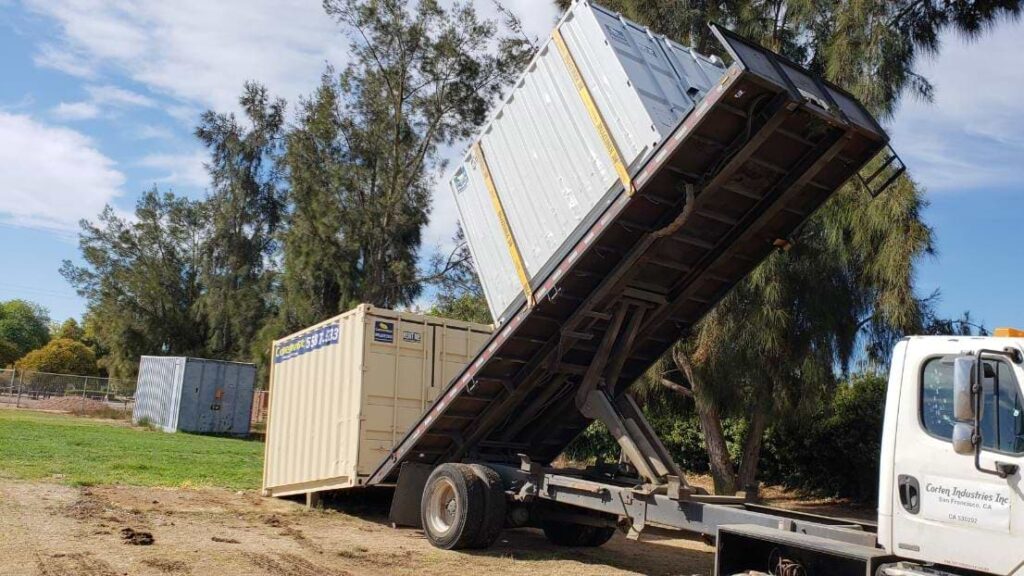Is it possible to move a container home? In this informative piece, we’ll unpack all the details you need to grasp.
Shipping container homes offer a unique twist on traditional living spaces. But can they be uprooted and moved?
The answer is a resounding yes! This article will guide you through the process of moving a shipping container home, ensuring you are armed with the necessary knowledge.
Delve in, and let’s explore together!

Key Takeaways
- Shipping container homes can be moved if they are designed with assembly in mind. If the containers can be separated, then the home can be relocated.
- Moving a shipping container home requires heavy equipment, such as a forklift or crane, to lift and load the containers onto a flatbed truck.
- Before moving a shipping container home, it’s important to clear out the interior and secure any items that cannot be removed.
- The containers can be disassembled using threshold plates and bolts, which makes them easier to transport.
- The method of transportation, such as a tilt bed truck or flatbed truck, depends on the distance of the move and the size of the container. Crane services may also be needed for loading and unloading.
When can shipping container homes be moved?
Can a shipping container home be moved? While the answer is a resounding yes, it’s not as easy as you might think.
The primary factor that enables the relocation of a shipping container home is its design. If the home is constructed in a way that allows it to be taken apart, then moving it is possible.
Think of it like a giant puzzle. If the individual pieces, or in this case, shipping containers, are welded together or fixed in a way that they can’t be separated, then moving the home isn’t possible.
However, if it’s designed with mobility in mind, this puzzle can indeed be taken apart and put together elsewhere.
How is the transportation done? Well, transporting a shipping container home isn’t a one-man job. It’s not feasible to move shipping containers without heavy equipment.
If you can handle the costs, the easiest way to move your container home is to use a forklift or a crane. You can hire professionals to do this part for you.
These machines lift and load the containers onto a flatbed truck. This method is the same one typically used for container deliveries and transport over long and short distances.
How to Move a Shipping Container Home
Moving a shipping container home might sound like a daunting task. But with the right equipment and a strategic plan, it’s entirely achievable. The first step involves understanding the type of container you have.
If you own a standard shipping container, you’re in luck. These types of containers are designed to be easily transported on trucks and trains.
In contrast, high-cube containers are a different ballgame. Due to their increased height, these containers require a specialized truck for transportation.
The distance you’re moving is another factor to consider. Short hauls should be relatively straightforward. Yet, for longer journeys, you might need to invest in specialized equipment to ensure a safe and efficient move.
But it’s not just about equipment and logistics. It’s also essential to brush up on your legal knowledge. Familiarize yourself with local laws and regulations about payloads and hauling in your area. This is especially important if you’re moving the container to a different region or state.

Transporting a Shipping Container Home
If you are planning to move your container home to a new location, then here are some steps you need to keep in mind:
Clear Out the Home
Once you have decided that you can move your container home, you will need to clear it out. This is perhaps the most important step and needs to be done thoroughly and completely.
If your container home has any framing inside, you can leave it. That means the walls, floors, and ceilings of your shipping container home are okay to stay as they are.
You do not need to take down the actual structure of the home’s interior, just the inside contents. Furniture, appliances, personal belongings—all must go.
Now, we understand that some items may be secured to the interior. In that case, you might be able to strap them down and fasten them securely. Professional moving companies can help you with this.
These companies are the go-tos for reliable information. They’ll guide you on how to secure items for transportation and how to empty the container optimally.
Plus, they’ll help you adjust your equipment for container transportation. So, for the safety of your belongings during the move, consulting with them is a smart move.

Disassemble the Containers
Start by separating the containers. This is done using threshold plates and bolts. This might seem trivial but it’s a step that can save you a lot of hassle down the line.
Welding the containers together may seem like a good idea. After all, it makes them stronger. However, it also makes them harder to take apart.
By using threshold plates and bolts, you’re making the containers easy to detach. This means you can transport them with ease.
So, when the time comes to pack up and move, just unbolt the containers. They’ll come apart like magic.
This method isn’t just easy. It’s also efficient and saves time. Plus, it means you can put the containers back together without any problems.
Choose a Transportation Method
Transporting a shipping container home is no small task. The method of transportation you choose can greatly impact the process.
There are two primary options to consider: a tilt bed truck and a flatbed truck. Each has its own advantages and disadvantages.
If you’re moving your container home a distance of less than 200 miles, a tilt bed truck comes highly recommended. This truck comes with a handy feature: its bed can tilt.
This means your container can easily be rolled onto the bed without needing any extra equipment like cranes or winches. It’s a time-saver and cuts down on effort.
However, if your new location is over 200 miles away, you might want to consider a flatbed truck. This option allows for long-distance transport.
But bear in mind that this method isn’t as straightforward as the tilt bed truck. Your container will need to be securely fastened to the truck. This is to prevent any shifts or damage during the journey.
A crane will be necessary for both loading and unloading. So, this option can be more costly and time-consuming.

Unload the Containers
Arriving at your new spot marks the beginning of the next phase: unloading your shipping container home. Equipped with the right tools and techniques, this process can be a breeze.
If your journey involved a flatbed truck, a crane would be necessary for unloading. On the other hand, tilt-bed trucks simplify this step. You can effortlessly slide off the containers, eliminating the need for a crane.
Before you start the unloading process, make sure your utilities are ready for connection. This crucial step can prevent any last-minute hitches that could complicate matters.
With a well-prepared plot of land, you can be sure that the unloading process will run smoothly and efficiently.
Once the containers are safely on the ground, it’s time to reassemble your home. Bolts and threshold plates should do the trick.
After securing the containers in their new home, you can begin the exciting task of moving your belongings back in.
The unloading process, when carefully planned and executed, can save you plenty of time, effort, and money. So, gear up, and prepare to enjoy your container home in its brand new location.

Cost to Move a Shipping Container Home
On average, moving a shipping container home can cost anywhere from $500 to $5,000, or even more. This number can vary greatly depending on various factors, such as:
Distance
The distance between the current location and the new destination can significantly impact the cost of moving a shipping container home. Longer distances usually mean higher transportation costs.
Container size and weight
Larger and heavier containers will require larger trucks and more equipment to move them, resulting in higher costs. Standard shipping containers are typically either 20 or 40 feet long, but other sizes are also available.
Permits and regulations
Depending on local regulations, permits may be required to transport a shipping container home, and these can add to the cost.
Additional services
If specialized equipment or services are required to move the container, such as a crane or additional labor, this can increase the overall cost.
Conclusion
Moving a shipping container home is definitely possible, but it requires careful planning and logistical considerations.
It’s a process that requires careful planning and execution. With the steps we covered here, you’re assured of a successful transition.
So, if you’re ready to embark on an adventure in alternative housing, don’t let the idea of moving a shipping container home deter you.
With the right preparation and a bit of creativity, your dream of living in a portable, eco-friendly abode can become a reality.
If you want to learn more about container home living, check out our helpful guides here.


